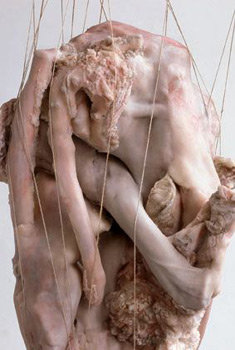Life?
dal 25/9/2008 al 10/1/2009
Segnalato da
Ruth Asawa
Louise Bourgeois
Berlinde de Bruyckere
Lee Bul
Wolfgang Flad
Gabriela Frioriksdottir
Siobhan Hapaska
Julie Hayward
Georg Herold
Agnieszka Kalinowska
Liz Larner
Ernesto Neto
Carsten Nicolai
Pino Pascali
Jill Spector
eva helene
stern
Franz West
Xiao Yu
Xu Zhen
Katrin Bucher Trantow
Peter Pakesch
25/9/2008
Life?
Kunsthaus Graz am Landesmuseum Joanneum, Graz
Biomorphic Forms in Sculpture. The exhibition investigates organic, biomorphic and anthropomorphic forms and offers an extensive exploration of the subject, with pictures of life that are rampant and threatening as well as cosy and friendly. Biomorphism represents transformation and fluidity, evolution from one state to the next. It is governed by processes operating on fundamentals, determining all works in different ways. Curated by Katrin Bucher Trantow, Peter Pakesch.

Curated by Katrin Bucher Trantow, Peter Pakesch
Can art help us to understand complex three-dimensional configurations of nature better? The exhibition Life? Biomorphic Forms in Sculpture investigates organic, biomorphic and anthropomorphic forms and offers an extensive exploration of the subject, with pictures of life that are rampant and threatening as well as cosy and friendly.
Biomorphism represents transformation and fluidity, evolution from one state to the next. It is governed by processes operating on fundamentals, determining all works in different ways. Etymologically derived from the Greek words bios (mode of life) and morphé (form), the term seems to have come into use in the 1930s, when it described the visual style of the Surrealists. The artists in the present exhibition follow the same tradition, sharing an interest in the archaic and fundamental. An odd accumulation of magic realism is the result that creates myths and triggers off discussion about mankind's manipulation of organic tissue.
Particularly Berlinde de Bruyckere's fragmented Laocoön, Louise Bourgeois's embryonic exhibit, Georg Herold's paraphrase of faith in science and Xiao Yu's shocking fabulous flesh creature go directly and corporeally to extremes, opening up a debate on topical subjects such as genetic manipulation, cloning and research into the creation of artificial life. In a dialogue between a Frankenstein sci-fi monster and a mystic creature, Lee Bul's Transcription (Drift & Scatter) is also reminiscent of the celebrated Nike of Samothrace. Wolfgang Flad sets up a rather ironic link with art history in making his bone sculptures in an unusual arrangement of constellations from pulped art books. The works of Gabríela Friðriksdóttir oscillate between waking and sleeping, the worlds of travel drawn from the imagination and plunging into a warm spot smelling of fresh hay. Julie Hayward also speaks with the language of the unconscious, and like Siobhán Hapaska creates forms in the vein of utopian 60s' design. In the ur-forms of eva helene stern***, American artist Ruth Asawa and Brazilian Ernesto Neto we are taken back to the origins, to cells and condensates. Neto's outsize objects are sensory objects of self-experience and, like the works of Agnieszka Kalinowska, Liz Larner and Xu Zhen, open up sculptural space to bring in the biomorphic architecture of the Kunsthaus Graz itself. Franz West's psychotic distortion is a form of metamorphosis constantly disowning itself in irony, though like Pino Pascali and Jill Spector it does not lose its touch of oppressive menace. Carsten Nicolai's cluster moves at the interface of science and art, making it clear – though not even here without an undertone of ironic doubt – how art can help us understand complex three-dimensional phenomena better.
Artists of the exhibition:
Ruth Asawa (US), Louise Bourgeois (FR/US), Berlinde de Bruyckere (BE), Lee Bul (KR), Wolfgang Flad (DE), Gabríela Friðriksdóttir (IS), Siobhán Hapaska (UK), Julie Hayward (AT), Georg Herold (DE), Agnieszka Kalinowska (PL), Liz Larner (US), Ernesto Neto (BR), Carsten Nicolai (DE), Pino Pascali (IT), Jill Spector (US), eva helene stern*** (DE/AT), Franz West (AT), Xiao Yu (CN), Xu Zhen (CN)
A catalogue accompanies the exhibition. It contains numerous images and text contributions by Katrin Bucher Trantow, Thomas Macho, Gloria Meynen und Peter Pakesch.
Programme
Tue, 28.10.2008, Needle/Discussion
Kunsthaus Jour Fixe 22:
Science and Fiction - or: the Freedom of Art
"Art is a lie that shows us the truth." Pablo Picasso (1881-1973)
Art has always helped out science by making its insights visually accessible and comprehensible, and at the same time has acted as an inexhaustible fount of inspiration. Today, when the dissolving frontiers of technology lead to a fusion of science and fiction, a new subject for discussion has opened up - where do aesthetics end and ethics begin?
Finissage
Performance of the Icelandic artist Gabríela Friðriksdóttir, in collaboration with the choreographer and dancer Erna Ómarsdóttir
Image: Berlinde de Bruyckere, In Doubt, 2007-2008 (Fundación Sorigué, Spain; Photo: Mirjam Devriendt, Courtesy Galleria Continua San Gimignano-Beijing).
Press contact:
Mag. Daniel Kogler T: +43 316/8017-9213 F: +43 316/8017-9253 E-Mail: presse@kunsthausgraz.at
Sabine Bergmann T: +43 316/8017-9211 E-Mail: sabine.bergmann@museum-joanneum.at
Opening Sept 26, 2008, 7pm Space01
Kunsthaus Graz am Landesmuseum Joanneum
Lendkai, 1 - Graz
Tue - Sun: 10am - 6pm



